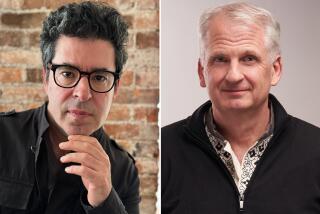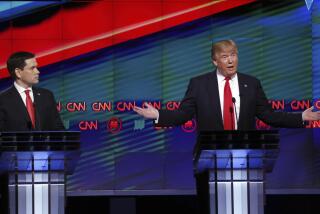The Evolution of the Neocons
- Share via
The term “neoconservative” started out as an insult, and it is still used that way. When people say that the selection of Paul Wolfowitz to head the World Bank marks the triumph of neocons in Bush administration foreign policy, they are generally not indicating pleasure. Some cynics even say the “neocon” label is anti-Semitic: Doesn’t it just refer to a Jewish intellectual you disagree with?
That’s way too harsh. But what does neoconservative actually mean? Rich Lowry, a conservative of the non-neo variety writing in the current issue of the National Interest, defines a neocon as someone with a “messianic vision” of using American power to spread democracy, an indifference to the crucial distinction between what would be nice and what is essential to national security, and excessive optimism that we can arrange things according to our own values in strange and faraway lands.
Wow. It was not always thus. When the word first surfaced in the 1970s, its sting was in calling people conservatives five or 10 minutes before they were prepared to admit it. The core group had famously been Trotskyites at City College in the 1930s. By the 1950s and 1960s, they had become anti-Communist liberals and supporters of the Vietnam War. The antiwar movement and the ‘60s counterculture alienated them and pushed them even further to the right. Affirmative action was another sore point. Finally, Irving Kristol, dubbed the neocon godfather, decided to take the name as a compliment. He defined a neoconservative as “a liberal mugged by reality.” (That phrase also summarizes the plot of the Great Neocon Novel, “Mr. Sammler’s Planet,” by Saul Bellow. Bellow’s last novel, “Ravelstein,” actually has a character modeled after Wolfowitz.)
The great neocon theme throughout this period was tough-minded pragmatism in the face of liberal naivete. Liberals were sentimental. They believed that people were basically good or could easily be made so. Domestically, liberal social programs were no match for the intractable underclass or even made the situation worse. Internationally, liberals were too hung up on democracy and human rights, refusing to recognize that the only important question about other countries is: friend or foe.
Somewhere I still have a souvenir of neoconservatism’s previous high point. It’s a baseball cap from the 1988 Republican convention that says, “Jeane Kirkpatrick for vice president.” This was serious. Kirkpatrick, an austere academic with a crooked scowl, was about as unlikely a politician as you can imagine. But give the Republican Party credit: It does sometimes swoon over ideas. (When was the last time the Democrats did that?) Ronald Reagan had swooned over a 1979 article by Kirkpatrick in Commentary, the neocon house organ, and he made her his U.N. ambassador when he became president. She gave the big speech at the 1984 GOP convention, leading the massed Republicans in a chant of: “They always blame America first.”
Kirkpatrick’s article, “Dictatorship and Double Standards,” was a ferocious attack on President Carter for trying to “impose liberalization and democratization” on other countries. She mocked “the belief that it is possible to democratize governments anytime, anywhere, under any circumstances.” Democracy, she said, depends “on complex social, cultural and economic conditions.” It “normally” takes “decades, if not centuries.” Kirkpatrick thought that American power should be used to shore up tottering but friendly dictators, like Anastasio Somoza of Nicaragua and the shah of Iran. Her complaint was that Carter sat on his hands.
Now we have an administration that -- wisely or foolishly, sincerely or cynically -- claims to have the aggressive pursuit of democracy everywhere as the focal point of its foreign policy. And the Bush Doctrine is said to have the fingerprints of neoconservatives all over it.
This is quite a reversal by the most influential group of American intellectuals, yet it has received surprisingly little comment or explanation. The chief theoretician of the new neoconservatism is political scientist Robert Kagan. Writing in Commentary (where else?) in 1997, Kagan noted the difference between his notions and Kirkpatrick’s, and had some fun at the expense of opponents who had been all for a high-minded foreign policy until the neocons started calling for one. But he had little to say about the reversal of the neocons themselves.
Plenty of explanations are available. The collapse of the Soviet Union (which the neocons did not predict -- their theme had been that the Soviet Union was getting stronger and stronger while the U.S. diddled) surely changed the calculus. The seemingly easy spread of democracy over the last couple of decades may have disproved Kirkpatrick’s pessimism. But all these explanations require an admission of error, something the neocons are not very good at. They are selling certainty.
More to Read
Sign up for our Book Club newsletter
Get the latest news, events and more from the Los Angeles Times Book Club, and help us get L.A. reading and talking.
You may occasionally receive promotional content from the Los Angeles Times.










